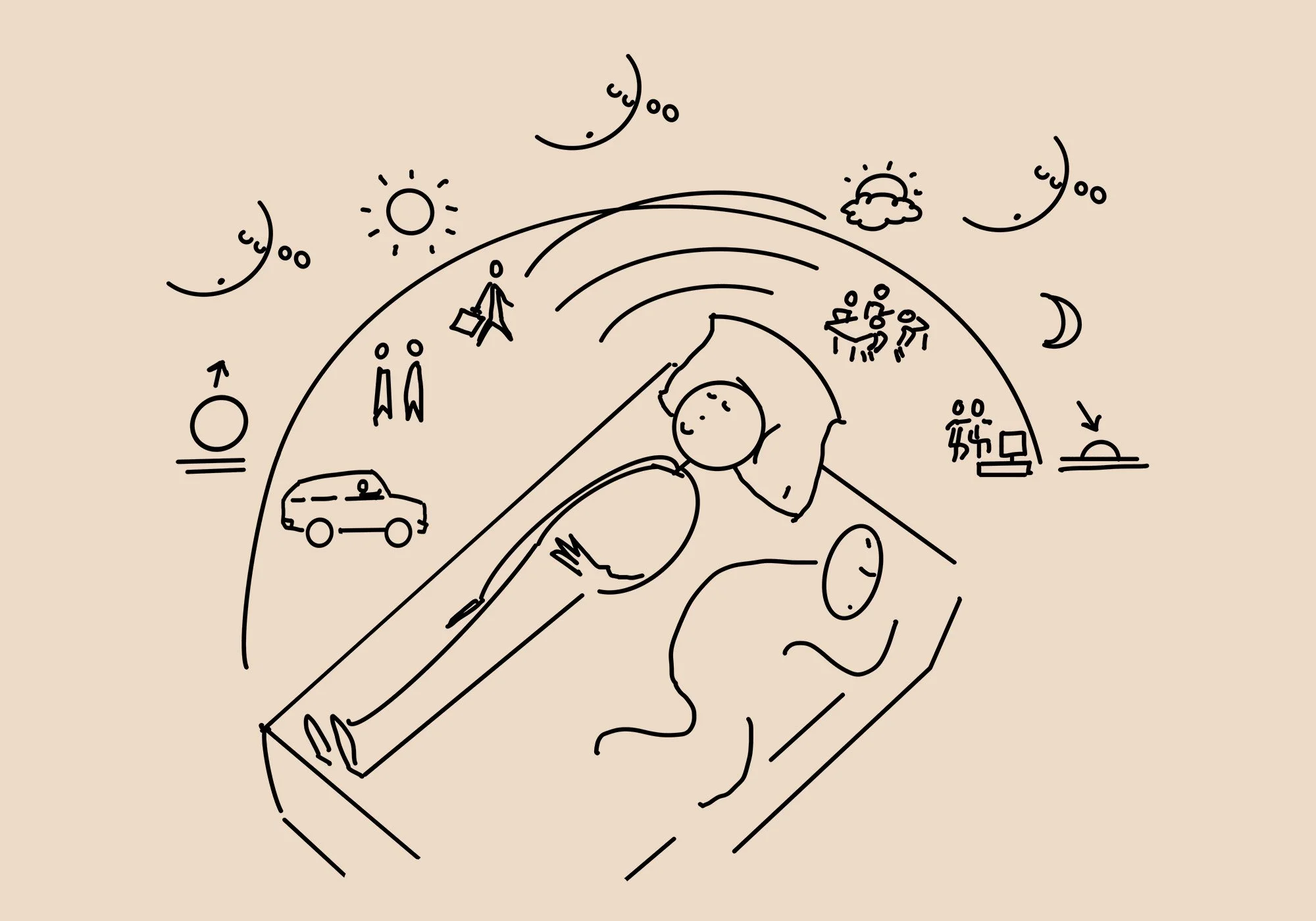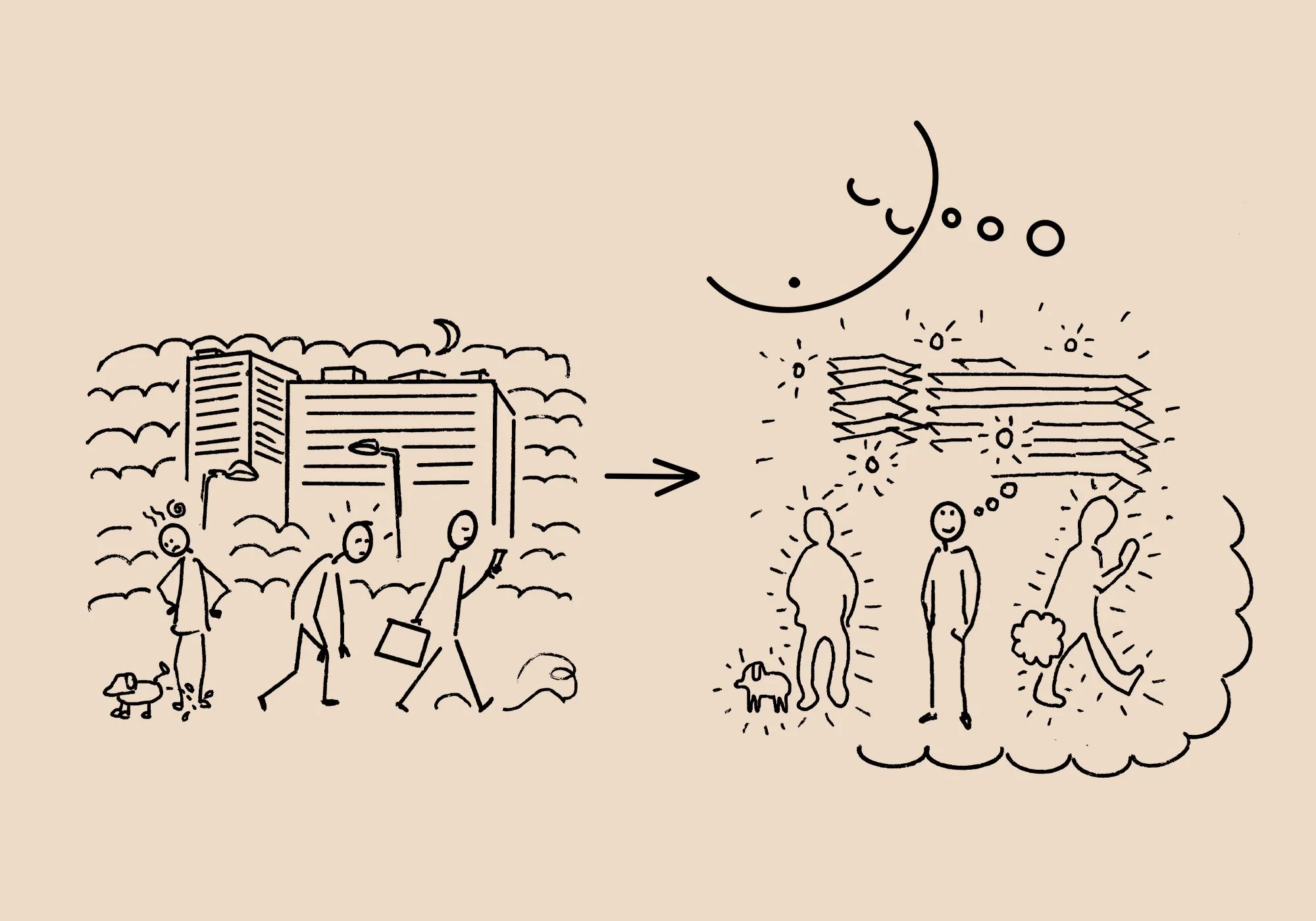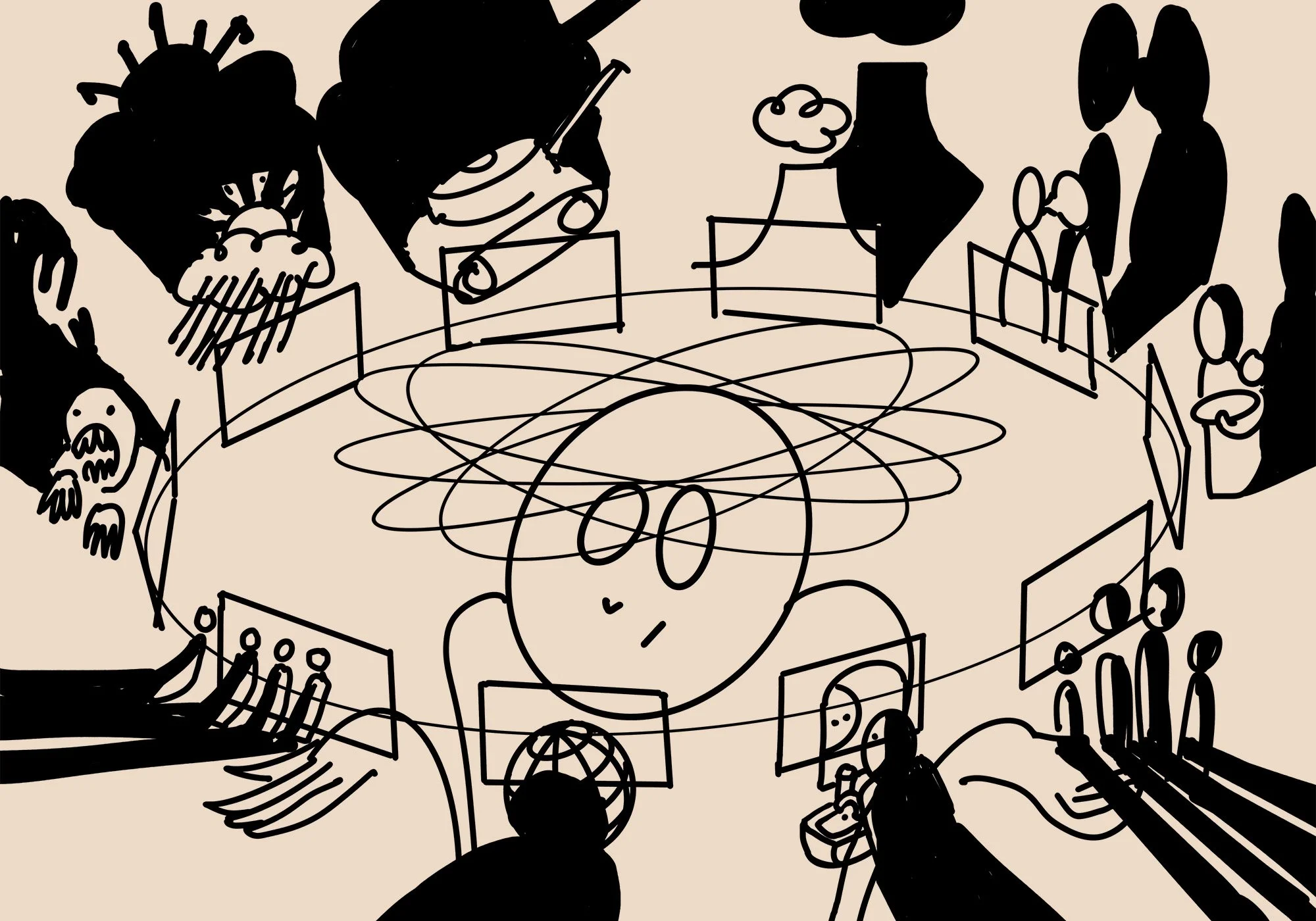MIND-FIRST PRACTICES
Tools for Inner Navigation
Field experiments within the consciousness-first framework — tuning perception to test awareness as both terrain and compass.
Last updated: October 9, 2025Practice Finder
Find the field test that fits your moment.
difficult conversation · relational tension · harsh judgment · unexpected change · transition between roles · feeling confined · sensory overload · emotional recovery · transition between roles · morning stillness · starting fresh · setting intention · preparing for interaction · centering before activity · quiet before engagement · first breath of the day · overstimulation · energetic drop · fast transitions · needing perspective shift · during pause between tasks · routine moments · neutral observation · environmental awareness · gossiping · collective tension · habitual judgment of others · persuasive opinion · traumatic story · creative reset · visual saturation · simplifying artistic impulse · beginning a new project · editing process · redefining priorities · aesthetic re-evaluation
TOOL DESIGN
Think of perception
like a dial —
it can amplify
static into captivity,
or tune into
clarity.
Continuously exploring new tools that might help us shift toward a consciousness-first identity — like the Dreamer’s Compass, a framework for tuning perception itself.
Have you tried the experiment’s core practices—an invitation to live the premise itself: We The Dreamer? Step back →
[TUNING:]
1. The Dreamer’s Compass (Four Cs) — Orienting Toward the Dreamer
Mind-state spotting tool — use anytime you’re “in it”
Field sketch 1. — visual cue, not final symbol — The four mind-states circling toward the dotted figure — awareness remembering itself.
If consciousness comes first, then the mind is both terrain and compass.
The Dreamer’s Compass turns that premise into something you can test directly — a four-point map for noticing how awareness moves inside the dream and for switching mental stance from body-identified perception to mind-aware orientation.
Each “C” marks a shift in mind’s orientation:
Captivity — The Captive ∞, caught in the story.
Curiosity — The Flâneur ∞, observing with detachment.
Chemistry — The Alchemist ∞, transforming perception.
Clarity — The Dreamer ∞, resting as awareness itself.
Together, these four stances form the Four Cs Framework — a practical exercise for shifting mindsets within the consciousness-first hypothesis.
By tracing the Compass, you’re not chasing states but switching reference points: from seeing the body as an effect of the world to recognizing mind as its source.
With use, the Compass becomes intuitive — you learn where you get stuck, how to quiet the mind, and how to open to the presence (or quiet guidance) of the Dreamer itself.
The experiment isn’t to climb or purify, but to notice, name, and nudge.
What changes when perception leans, even slightly, toward the Dreamer’s stance?
Tool Usage:
Use the Compass whenever you notice you’re “in it.” Identify your current C. → Name the state silently — “Captivity,” “Curiosity,” “Chemistry,” or “Clarity.” → Shift to the next C’s stance using its micro-practice. → Rest when stillness shows up; drop the labels.
The movement isn’t linear — it’s cyclical, like breath. Each loop through the Compass is a micro-awakening, a rehearsal of the consciousness-first experiment in daily life.
Why It Matters:
The Compass offers a way to see perception at work — not as belief, but as field observation. Labeling breaks the trance; shifting orientation reveals that awareness is both observer and terrain. Used solo or with a partner, the Compass becomes a shared experiment: naming your state together often accelerates the shift.
Field Note: Most maps aim to explain the world; this one maps the dreamer of it. Each point on the Compass is an aperture through which reality redraws itself.
Open the full exercise page →This practice explores:
Principle 1 — World as Cause → Mind as Cause
Principle 7 — Conflict Is Real → Peace Is What Is

All drawings by Martin Lenclos. These are field sketches — visual cues for perception shifts. They’re not polished artworks or fixed symbols, but provisional notes from the experiment: playful, imperfect, and open to your own interpretation.
[VISUALIZATION:]
2. Open Mind, Open Space — Loosening Identity into the Dreamer
Embodiment loosened through visualization and mental spaciousness.
Field sketch — visual cue, not final symbol — awareness widening beyond its frame.
If consciousness comes first, then the body isn’t the self but a projection of it—a temporary device, healthy or sick, through which awareness plays.
Open Mind, Open Space is a visualization in the consciousness-first experiment for loosening identification with form and allowing awareness to reoccupy its native field.
The exercise is simple: imagine opening a space within the mind—a gate, a chamber, a clear sky. Leave roles, grievances, attributes, and stories outside this space, as if stored in a locker. What remains is not effort but invitation: the mind giving way to the presence of consciousness—the Dreamer. You don’t force awareness in; you allow space for it to flow. The shift is from occupying the body to offering it up as openness.
Tool Usage: Visualize the opening — sense the mind expanding, upward or outward, until awareness fills the frame.
Set down the weight — place your personal stories, identities, and concerns outside this inner space.
Optional layer: If helpful, imagine handing these to luminous archetypes—sages, teachers, guides, or simply symbols of clarity. Let them hold your burdens while you test how light the mind feels when uncluttered.
Stay empty — when the field feels open and clear, rest there. The practice ends in presence, not perfection.
Why It Matters: Because space itself is the Dreamer’s nature. Each time you release identification, awareness remembers its true scale. The body softens, thought quiets, and perception becomes transparent again. Awakening isn’t an achievement but an invitation—testing what happens when the mind stops filling the sky.
Field Note: Many experience this as expansion—space widening in all directions—or as ascension, like rising through the layers of thought into thinner air. Both reveal the same thing: awareness is larger than the form it once mistook for self.
This practice explores:
Principle 4 — Identity Is Personal → Identity Is Universal
Principle 10 — We Are Lost → We Are Dreaming
[TUNING:]
3. Premise Protocol — Beginning the Day as the Dreamer
A morning calibration for testing consciousness-first perception.
Field sketch — visual cue, not final symbol — awareness re-awakening inside the dream before the world begins to seem real.
If consciousness comes first, then every day begins as a new dream.
Premise Protocol is a morning discipline for re-entering that dream deliberately—choosing a perceptual stance before the world begins to pull you into its story. It tests a simple hypothesis: what changes in the day’s flow when awareness, not circumstance, defines the frame?
Tool Usage:
1. Before the day begins, pause while still in bed or just after waking. Remember: you are the Dreamer, not the dream.
2. Set the premise.
Silently state: “I am the cause of the world, not its effect.” Let that become the perceptual filter through which the day unfolds.
3. Sense the handover.
As thought and sensation return, notice how easily the dream of separation starts running—roles, plans, anxieties. Re-establish authorship. You are the field in which these images appear.
4. Carry the stance.
Throughout the day, when the world feels overwhelming, quietly recall: “This was my chosen premise. Let me see how mind shapes what I see.”
Why It Matters: Every morning is a design moment. The first premise you adopt is the operating system of perception for the day. Instead of entering the dream reactively, this tool turns awakening into a conscious act of authorship. It’s not control—it’s direction of attention.
Field Note: The simple act of morning orientation shifts how we interpret everything that follows—from traffic and meetings to chance encounters. Reality feels less like a stream of demands and more like an unfolding interface of mind.
Over time, you may notice subtle correlations: emotional turbulence lessens, synchronicities increase, and neutrality becomes available faster. These are not proofs, but phenomenological signals that the experiment is active.
This practice explores:
Principle 1 — World as Cause → Mind as Cause
Principle 9 — Awakening Is an Attainment → Awakening Is a Return
[TUNING:]
4. Tune the Frequency — Listening for the Dreamer’s Signal
Mental dial for signal clarity and perceptual elevation.
Field sketch — visual cue, not final symbol — awareness rising from the noise of the dream into the lucid field of the Dreamer.
If consciousness comes first, then perception isn’t passive reception but active tuning.
Tune the Frequency tries that hypothesis through orientation rather than effort: shifting awareness from noise to field, from density to spaciousness. Instead of trying to feel better, the experiment asks whether you can sense the lucid tone already present—the Dreamer’s resonance beneath the static of the world.
Tool Usage: Pause and Ask: “What frequency am I on?”
Lean the mind upward or outward—imagine perception rising like an elevator, or widening like a lens—until noise thins and presence expands.
Feel with your mind. Observe even with eyes closed. Listen with your heart.
You’re not manufacturing calm; you’re detecting clarity.
Rest when perception feels less entangled, not more perfect.
Use this anytime you feel mental clutter, moral panic, or conceptual fatigue.
No mantra needed. The dial is the noticing itself.
Field Note — On Frequency, Vibration, and Mindspace: Different metaphors point to the same experience. Some feel it as frequency: a cleaner signal emerging beneath thought. Others sense vibration: a subtle resonance in the body-mind field. Still others describe it as mindspace: awareness widening until all forms fit within it. The orientation doesn’t matter; the outcome does. The body feels lighter, the mind quieter, perception more transparent.
Eckhart Tolle called this the “vertical dimension of presence.” Here, it’s treated as design research: what changes when awareness shifts altitude?
This practice explores:
Principle 1 — World as Cause → Mind as Cause
Principle 9 — Awakening Is an Attainment → Awakening Is a Return
[VISUALIZATION:]
5. Keep It Light — Seeing the World as the Dreamer’s Idea
A daily visualization protocol for re-perceiving the world as projection, not mass.
Field sketch — visual cue, not final symbol — the everyday scene lightened into transparency of mind.
If We The Dreamer proposes that one mind dreams the world, then Keep It Light is its training protocol in motion. It’s not for crisis—it’s for routine: the commute, the meeting, the sidewalk, the scrolling feed. Each scene becomes a live experiment in reframing solidity as appearance, event as idea.
In the consciousness-first model, weight—of mood, matter, or meaning—is a byproduct of taking perception as fact. This visualization reverses that assumption. As you move through your day, you test how form changes when regarded not as external substance, but as projection within mind—part of the Dreamer’s own image stream.
The Practice: As you step outside, start the experiment. Let your environment appear as if it were imagined in real time: outlines softening, colors brightening, air alive with awareness. Whisper, “Keep it light.” Notice how solidity yields to movement—how buildings, people, and moments begin to feel like thoughts rendered visible.
Carry it into transitions: walking, driving, entering a room, opening your laptop. Don’t fix the world; test its transparency. Each repetition trains perception to reference the Dreamer’s field rather than the body’s coordinates.
Micro-Cue for the Experiment: “Keep it light.”
Let it mean: Don’t anchor in form.
Don’t confuse weight with truth.
Don’t stop at surface.
Behind the scene, there is the idea.
Behind the image, there is mind.
And when you keep it light, you remember the world as thought in motion.
Up-Layering Note: Use the practice as a daily calibration of perception.
Each lightening is an up-layer—from matter to pattern, from event to awareness.
You’re not escaping reality; you’re training attention to see its source in consciousness itself.
This is how the Dreamer learns to move lucidly within its own creation.
This practice explores:
Principle 1 — World as Cause → Mind as Cause
Principle 2 — Separation Exists → Only Appearances of Separation
[REMINDER:]
6. Watch the Mind’s Channels — Returning to the Dreamer’s Seat
Observer stance for emotional reactivity or cultural hypnosis.
If consciousness comes first, then the mind isn’t a receiver of reality but the studio producing it. Watch the Mind’s Channels turns that premise into a test of perceptual distance: can you stay one step back from the content streaming through you?
Throughout the day, countless “programs” run automatically — news feeds, body worries, emotional loops, social comparisons, moral debates. Each is just a channel in the mind’s broadcast system. You can step into the storyline, or you can notice that you’re watching a show. The moment you do, perception lifts — the Dreamer remembers itself behind the screen.
Tool Usage: Notice the broadcast — when a strong emotion or thought stream arises, pause and name the channel. It might appear as:
a friend criticizing another friend → “the judgment channel.”
the news reporting catastrophe or injustice → “the fear or outrage channel.”
the body looping a self-critical thought → “the shame channel.”
the mind forecasting failure or loss → “the anxiety channel.”
even the weather predicting doom → “the drama channel.”
Each label reminds you: this is a program playing in the mind’s field, not the field itself.
Step back one seat — see if awareness can rest behind the viewer rather than inside the scene. Test the switch — without suppressing anything, silently choose: watch, change the channel, or turn off the set for a moment. Return lucidly — re-enter the situation if needed, but from the Dreamer’s stance — clear, not caught.
Why It Matters: Because clarity begins where identification ends. When you watch the mind instead of being the mind, emotional charge lessens, compassion grows, and the Dreamer’s signal becomes audible again. You stop arguing with the show and start recognizing it as your own creative projection.
Field Note: This tool tests whether labeling a thought-stream as a “channel” (e.g., anger, self-doubt, news) increases perceived distance from the storyline and reduces reflexive identification.
This practice explores:
Principle 1 — World as Cause → Mind as Cause
Principle 8 — Others Need Fixing → All Healing Is Internal
Field sketch — visual cue, not final symbol — awareness watching the world’s broadcast from the quiet seat within.
[Design:]
Design for Nothing — Using the Power of Positive Miscreation
An aesthetic practice for loosening grasp and making space.
An applied method of artistic and design exploration within the Dreamer Project. Here, objects, layouts, and gestures are pared down to remove excess grasping—form is treated not as expression but as interruption, opening space for perception itself. This is not minimalism for style’s sake, but a practice of non-possession through form: furniture that points past use, language that thins into silence, design that erases itself.
Learn the approach →*ABOUT THIS EXPERIMENT
The Dreamer Project and its affiliated materials (including “We The Dreamer” and the Practice Library) explore a consciousness-first worldview through creative and phenomenological means. These materials are experimental in nature. They make no claims of scientific proof or therapeutic efficacy. No empirical evidence currently confirms or denies the hypothesis that consciousness is fundamental to reality, nor that these practices produce measurable benefits. Participation in this project is voluntary and self-directed. It may surface challenging reflections or unsatisfying results; that possibility is part of the inquiry. If you are navigating mental-health concerns or emotional distress, please seek guidance from a qualified professional. This work is offered freely for educational and philosophical exploration only — a field test in perception, not a path of belief.
META NOTES
This page is a living document. Last updated: Newly created on October 9, 2025






